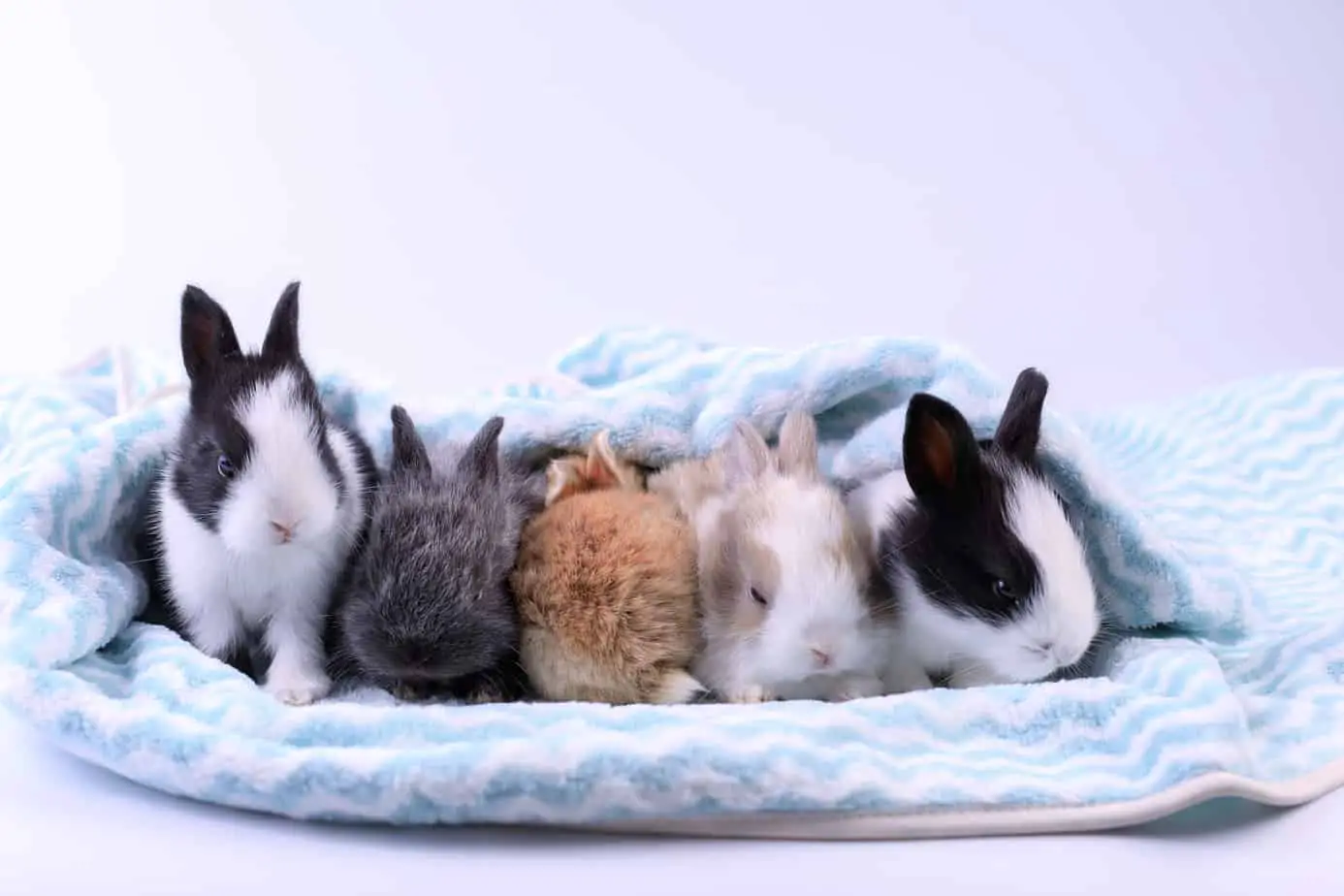
Rabbits are excellent companions, especially if you live in a small home or apartment. These pets are smart, fun to play with, and some are even known to be compassionate towards their owners.
The American Rabbit Breeders Association (ARBA) currently recognizes 50 different rabbit breeds. However, not all of these rabbit breeds are suitable for your home. Discovering the perfect rabbit breed for your specific life situation can take a little work, but carefully considering the defining qualities and temperaments of each breed can help ensure you make the best choice for yourself and your family.
The best pet rabbit breeds include:
- Mini-rex Rabbits
- American Rabbits
- Holland Lop Rabbits
- Lionhead Rabbits
- Dutch Rabbits
- Blanc de Hotot & Dwarf Hotot Rabbits
- Californian Rabbits
- Mini Lop Rabbits
- Checkered Giant Rabbits
- Satin & Mini Satin Rabbits
- Chinchilla Rabbits
- English Lop Rabbits
- Netherland Dwarf Rabbits
- Florida White Rabbits
- English Spot Rabbits
- Polish Rabbits
- Flemish Giant Rabbits
- Jersey Wooly Rabbits
- French Angora Rabbits
- Harlequin Rabbits
- Havana Rabbits
- Himalayan Rabbits
Here is an easy reference chart that shows these best pet rabbit breeds and breed qualities of each:
| Grooming | Size | Lifespan | Personality | Health Issues | |
| 1. Mini-rex Rabbits | Minimal Grooming | 3-5 Pounds | 5-7 Years | Social, Gentle, Kind, Calm | GI Stasis, Mites, Cancer |
| 2. American Rabbits | Minimal Grooming | 9-12 Pounds | 8-12 Years | Docile, Gentle, Calm | GI Stasis, Mites, Cancer, Malocclusion |
| 3. Holland Lop Rabbits | Low-Moderate Grooming | 2-4 Pounds | 7-14 Years | Friendly, Gentle, Kind, Energetic | GI Stasis, Mites, Cancer |
| 4. Lionhead Rabbits | Moderate Grooming | 2-4 Pounds | 7-10 Years | Friendly, Gentle, Fun-Loving, Energetic | VHD, Myxomatosis, Malocclusion |
| 5. Dutch Rabbits | Low-Moderate Grooming | 3-6 Pounds | 5-8 Years | Pleasant, Calm, Easy Going, Energetic, Social | GI Stasis, Cancer, Malocclusion |
| 6. Blanc de Hotot Rabbits | Minimal Grooming | 8-11 Pounds | 5-8 Years | Calm, Gentle, Friendly, Active | GI Stasis, Mites, Malocclusion, Cancer |
| Dwarf Hotot Rabbits | Minimal Grooming | 2-4 Pounds | 7-10 Years | Curious, Friendly, Playful, Energetic | GI Stasis, Mites, Malocclusion, Cancer |
| 7. Californian Rabbits | Low-Moderate Grooming | 8-11 Pounds | 5-10 Pounds | Shy, Gentle, Affectionate, Calm | GI Stasis, Mites, Cancer |
| 8. Mini Lop Rabbits | Low-Moderate Grooming | 3-6 Pounds | 7-14 Years | Patient, Fun-Loving, Affectionate, Trainable | GI Stasis, Mites, Malocclusion, Cancer |
| 9. Checkered Giant Rabbits | Low-Moderate Grooming | 11-20 Pounds | 5-6 Years | Independent, Fun Loving, Affectionate, Energetic | GI Stasis, Mites, Malocclusion, Cancer |
| 10. Satin Rabbits | Minimal Grooming | 6-10 Pounds | 5-8 Years | Calm, Gentle, Friendly, Independent | GI Stasis, Mites, Malocclusion, Cancer |
| Mini Satin Rabbits | Minimal Grooming | 3-5 Pounds | 5-8 Years | Gentle, Friendly, Playful, Skittish with Strangers | GI Stasis, Mites, Malocclusion, Cancer |
| 11. Chinchilla Rabbits | Minimal Grooming | 9-12 Pounds | 5-8 Years | Docile, Gentle, Playful, Calm, Intelligent | Malocclusion, Mites, Flystrike, and Cancer |
| 12. English Lop Rabbits | Minimal Grooming | 9-12 Pounds | 5-8 Years | Laid Back, Gentle, Calm, Inquisitive | Ear Problems, Mites, and Cancer |
| 13. Netherland Dwarf Rabbits | Minimal Grooming | 1-3 Pounds | 10-12 Years | Skittish, Aloof, Lively, Spunky, Slightly Wild | Malocclusion, Colic, and Cancer |
| 14. Florida White Rabbits | Minimal Grooming | 4-6 Pounds | 5-8 Years | Calm, laid Back, Tender, Friendly, Fun Loving | Malocclusion, Mites, and Cancer |
| 15. English Spot Rabbits | Minimal Grooming | 5-8 Pounds | 5-9 Years | Energetic, Inquisitive, Playful, Friendly | Malocclusion, Mites, Flystrike, and Cancer |
| 16. Polish Rabbits | Minimal Grooming | 2-4 Pounds | 5-9 Years | Energetic, Inquisitive, Playful, Friendly | Malocclusion, Mites, Flystrike, and Cancer |
| 17. Flemish Giant Rabbits | Minimal Grooming | 12-20 Pounds | 8-10 Years | Docile, Patient, Tolerant, Friendly | Malocclusion, Mites, GI Stasis, and Cancer |
| 18. Jersey Wooly Rabbits | Moderate Grooming | 2-4 Pounds | 7-10 Years | Docile, Patient, Gentle, Playful | Malocclusion, Mites, GI Stasis, and Cancer |
| 19. French Angora Rabbits | Moderate Grooming | 7-11 Pounds | 7-12 Years | Calm, Patient Gentle, Friendly | Malocclusion, Mites, GI Stasis, myxomatosis, and Cancer |
| 20. Harlequin Rabbits | Minimal Grooming | 6-10 Pounds | 5-8 Years | Playful, Docile, Intelligent Gentle | Malocclusion, Mites, GI Stasis, and Cancer |
| 21. Havana Rabbits | Minimal Grooming | 4-7 Pounds | 5-8 Years | Playful, Calm, Gentle, Affectionate | Malocclusion, Mites, GI Stasis, and Cancer |
| 22. Himalayan Rabbits | Minimal Grooming | 2-5 Pounds | 7-10 Years | Easy-Going, Gentle, Affectionate, Patient, Playful | Malocclusion, Mites, GI Stasis, and Cancer |
What Are The Best Pet Rabbit Breeds For Your Family?
With so many rabbit breeds to choose from, it can be challenging to find the best match for your family’s needs. However, rest assured, the perfect rabbit breed for you is out there. Below, I’ll show you the most family-friendly pet rabbit breeds and provide some breed characteristics of each.
The best pet rabbit breeds Include:
1. Mini-Rex Rabbits

| Care | Size | Lifespan | Temperament | Health Issues | |
| Mini Rex Rabbit | Minimal Grooming | 3-5 Pounds | 5-7 Years | Social, Gentle, Kind, Calm | Gi Stasis, Mites, Cancer |
The mini rex rabbit is a popular house pet in North America, especially for first-time rabbit owners. Mini rexes are from Europe, and are small, weighing up to only 3-5 pounds. Mini-rexes have an average lifespan of five to seven years but can live longer when properly cared for.
A mini-rex has long upright ears and comes in a variety of different colors including:
- Black
- Blue
- Castor
- Sable
- Chocolate
- Lilac
- Red
Mini-rexes are very social rabbits and are very gentle around children. They have a very calm personality and enjoy human interaction. This breed’s fur is very soft, and the undercoat requires some minimal grooming as a result of its dense fur. Rex rabbit breeds are also known to be hypoallergenic and shed much less than many other rabbit breeds. Mini rex rabbits are generally healthy but can develop health conditions that include gi stasis, mites, and uterine cancer.
2. American Rabbits

| Care | Size | Lifespan | Temperament | Health Issues | |
| American Rabbit | Minimal grooming | Up 9-12 Pounds | 8-12 Years | Docile, Gentle, Calm | Gi Stasis, Mites, Cancer, Malocclusion |
The American rabbit is another popular but rare breed for house pets. These rabbits can live anywhere from nine to twelve years and can weigh up to twelve pounds.
American rabbits come in two colors, blue and white, and have red eyes.
The American rabbit is calm, docile, and gentle; however, children should be careful while handling them because they startle easily. They have short fur that should regularly be groomed at least once a week. A common health problem with the American rabbit is the teeth becoming overgrown, called Malocclusion, so be sure to give them a good diet and some cardboard to help wear down this rabbit’s teeth.
3. Holland Lop Rabbits

| Care | Size | Lifespan | Temperament | Health Issues | |
| Holland Lop Rabbit | Low-Moderate Grooming | 2-4 Pounds | 7-14 Years | Friendly, Gentle, Kind, Energetic | Gi Stasis, Mites, Cancer |
Holland lops are small rabbits from the Netherlands that are very friendly and are very energetic. They weigh from two to four pounds, and you should be prepared for moderate shedding in the summer. Holland lops have long ears that hang down and can live between 7 and 14 years.
Holland Lops can have solid coloring or white patches and come in a variety of colors including:
- Black
- Blue
- Lilac
- Chocolate
- Creme
- Red
Holland lops are friendly and do well with gentle children. They have excellent temperaments and are considered one of the most popular breeds to have as house pets. Holland Lops are a relatively healthy breed but commonly suffer from Gi Stasis, Mites, and Cancer.
4. Lionhead Rabbits
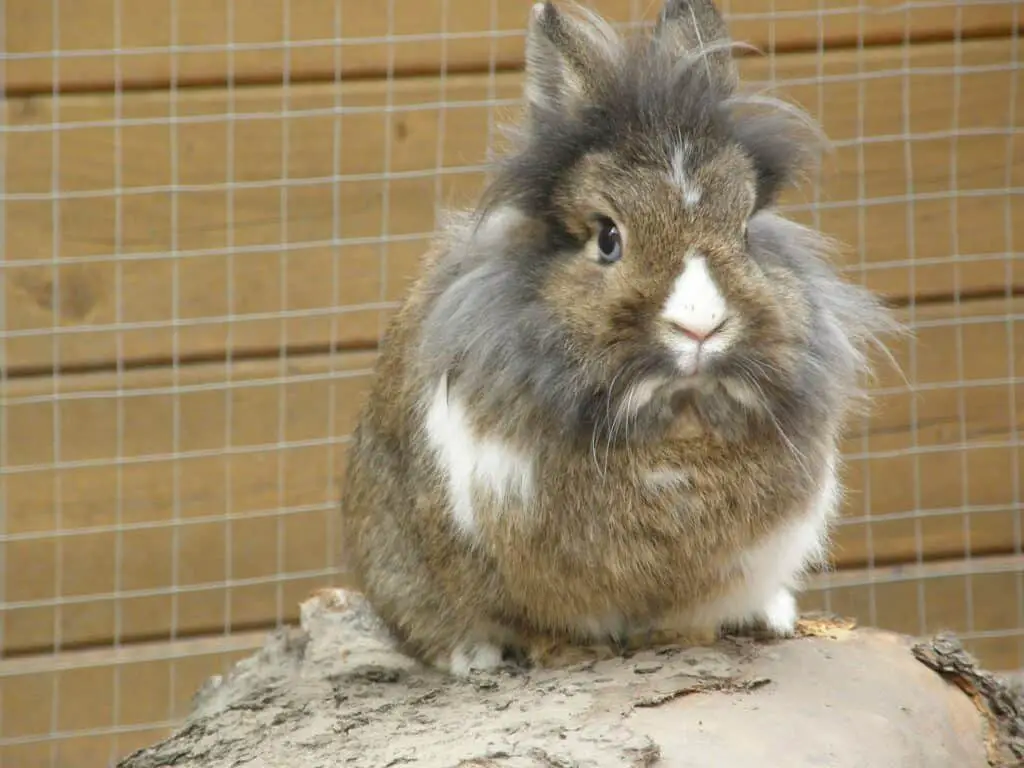
| Care | Size | Lifespan | Temperament | Health Issues | |
| Lionhead Rabbit | Moderate Grooming | 2-4 Pounds | 7-10 Years | Friendly, Gentle, Fun Loving, Energetic | VHD, Myxomatosis, Malocclusion |
The lionhead rabbit is a gorgeous rabbit to have as a house pet. They are famous for their fur around their head and neck that looks like a lion’s mane. This breed’s coat does need more grooming than most rabbit breeds due to their soft, dense fur. Lionhead rabbits typically reach two to four pounds and can live up to 10 years.
Lionhead rabbits come in a variety of colors including:
- Black
- Blue
- Frosted Pearl
- Orange
- Tan
- Chestnut
Lionhead rabbits are energetic and love to play. They are also one of the few breeds that enjoy being held, meaning they will do great with children. Lionhead rabbits are not prone to serious health problems but you should plan to vaccinate these rabbits to prevent Viral Haemorrhagic Disease (VHD) and Myxomatosis.
5. Dutch Rabbits

| Care | Size | Lifespan | Temperament | Health Issues | |
| Dutch Rabbit | Low-Moderate Grooming | 3-6 Pounds | 5-8 Years | Pleasant, Calm, Easy Going, Energetic, Social | Gi Stasis, Cancer, Malocclusion |
Dutch rabbits are from England and were bred to have their well-known markings. They have white bodies with dark fur on the ears, around their eyes, and a dark patch on their back. These rabbits are three to six pounds in weight and can live up to 8 years. This breed sheds a lot in the summer, so spending a little extra grooming time during these months can help keep their fur well-maintained.
Dutch rabbits will all have the above patterning, but colors can vary and include:
- Black
- Blue
- Chinchilla
- Chocolate
- Grey
- Steel
- Tortoise
Dutch rabbits are excellent house pets and are calm, pleasant, and easy-going. They need plenty of social interaction and exercise, as they are prone to depression if they are kept in a cage for too long. They are common house rabbits and are very popular with first-time rabbit owners. Dutch rabbits are not prone to any particular health issues but can develop Gi Stais, Overgrown teeth, and cancer as they get older.
6. Blanc de Hotot and Dwarf Hotot Rabbits

| Blanc de Hotot Rabbits | Dwarf Hotot Rabbits | |
| Grooming | Minimal Grooming | Minimal Grooming |
| Size | 8-11 Pounds | 2-4 Pounds |
| Lifespan | 5-8 Years | 7-10 Years |
| Temperament | Calm, Gentle, Friendly, Active | Curious, Friendly, Playful, Energetic |
| Health Issues | GI Stasis, Mites, Malocclusion, Cancer | GI Stasis, Mites, Malocclusion, Cancer |
Blanc de Hotots are giant rabbits from France. Their smaller breeds, Dwarf Hotots were developed in Germany by crossing the Netherland dwarf rabbit with the blanc de Hotot. Both breeds are well known for their white fur and a black ring around their eyes as if they are wearing eyeliner.
The Blanc de Hotot breed grows to between eight and eleven pounds and lives up to eight years. When fully grown, the Dwarf Hotot reaches two to four pounds and lives up to ten years. Blanc de Hotot and Dwarf Hotot rabbits come in only white.
Blanc de Hotot and dwarf Hotot rabbits make great family pets and are both very friendly, loving pets. The Dwarf Hotot tends to be very curious and energetic while Blanc de Hotot rabbits are slightly more gentle, calm, and are a better choice for families with small children. Neither breed is not prone to any particular health issues but often develops GI Stasis, Malocclusion, and cancer as they age.
7. Californian Rabbits
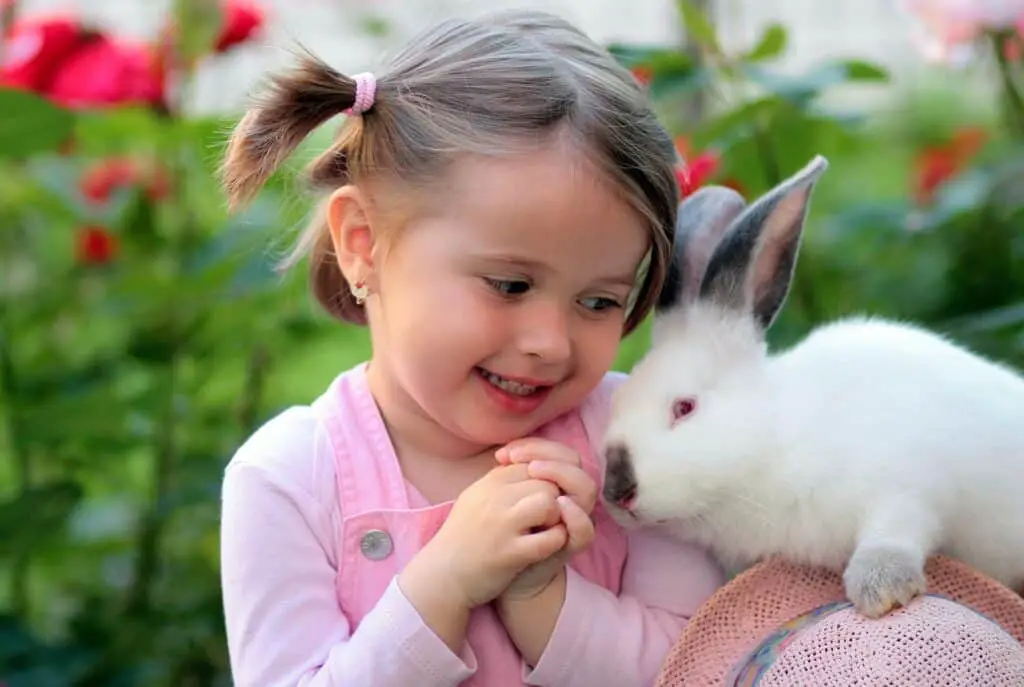
| Care | Size | Lifespan | Temperament | Health Issues | |
| Californian Rabbit | Low-Moderate Grooming | 8-11 Pounds | 5-10 Years | Shy, Gentle, Affectionate, Calm | GI Stasis, Mites, Cancer |
Californian rabbits are larger than most of the breeds mentioned so far and are also likely the shyest. They live up to 10 years and weigh between eight and eleven pounds. Their fur is dense, and they will shed a lot during the springtime.
While Californian rabbits will be mostly white, they can have a variety of colored points including:
- Chocolate
- Blue
- Black
- Lilac
Californian rabbits adjust well to older, gentle children once they are socialized to humans because they are so shy. They need a lot of exercise and love going outside. Since their fur is so dense, this breed should be groomed at least once a week. Californian rabbits also love playing in the snow (supervised, of course!) for a little bit. When bringing these rabbits in, make sure to dry them off and help them get warm.
Californian rabbits are not prone to any particular health concerns due to it’s breed. However, like many other rabbit breeds, Gi Stasis, Cancer, and mites are not uncommon.
8. Mini Lop Rabbits

| Care | Size | Lifespan | Temperament | Health Issues | |
| Mini Lop Rabbits | Low-Moderate Grooming | 3-6 Pounds | 7-14 Years | Patient, Fun Loving, Affectionate, Trainable | Gi Stasis, Mites, Malocclusion, Cancer |
Mini lops are adorable, medium-sized rabbits with floppy ears, usually used in competitions, and can easily be trained to do tricks. They can weigh up to six pounds and live up to 10 years when properly cared for.
Mini Lops come in a variety of colors including:
- Black
- Blue
- Chocolate
- Lilac
- Chestnut
- Sable White
Mini lops are patient and have an excellent temperament. They enjoy playing, cuddling, and are one of the few breeds that like being held. They tend to get depressed if they do not have enough intellectual stimulation, so make sure to train them to do tricks and give them plenty of toys and obstacles to play with.
As for health concerns, Mini Lop Rabbits most commonly diagnosed with GI Stasis, Mites, Malocclusion, and Cancer.
9. Checkered Giant Rabbits
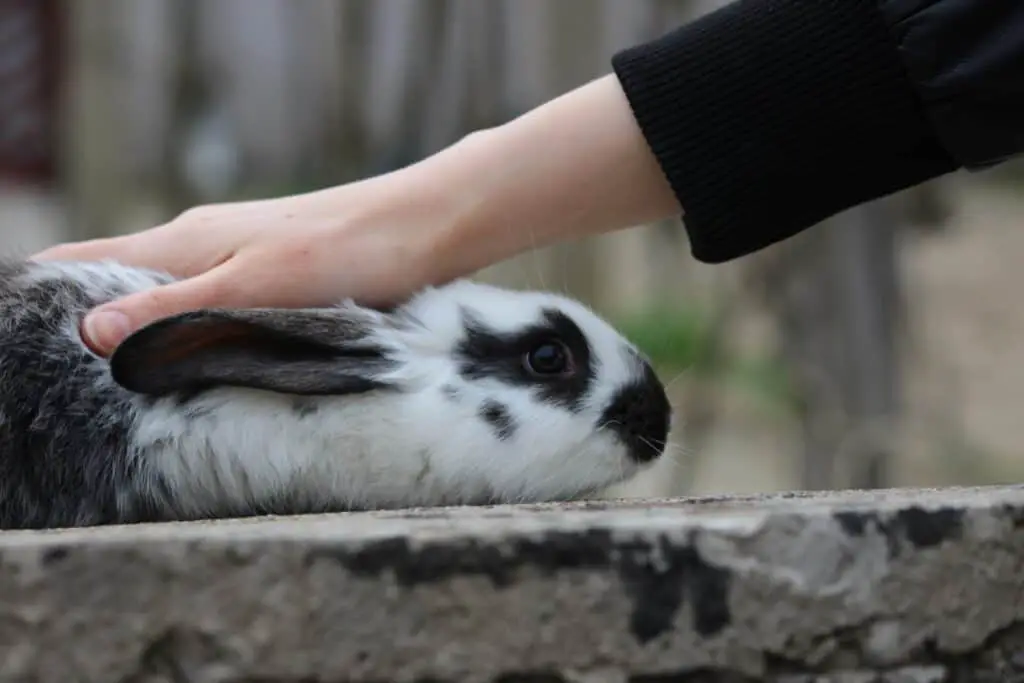
| Care | Size | Lifespan | Temperament | Health Issues | |
| Checkered Giant Rabbits | Low-Moderate Grooming | 11-20 Pounds | 5-6 Years | Independent, Fun Loving, Affectionate, Energetic | Gi Stasis, Mites, Malocclusion, Cancer |
The checkered giant rabbit is one of the largest rabbit breeds. ARBA (American Rabbit Breeders Association) states that there is no maximum weight for this breed. However, there is a minimum weight of 11-12 pounds for adults. They can be bigger than most cats and some dogs! They have a white body with black ears and black or blue patches throughout their body and on their faces. They require minimal grooming but need a little extra brushing during molting.
Checkered Giant rabbits are more independent than most breeds and do require a lot of exercise and space. They aren’t recommended for children because they can sometimes be aggressive, especially if they have been pent up in a cage.
Checkered Giant Rabbits typically have a shorter life span of five to six years, but they are not an unhealthy breed. Checkered Giants are most commonly affected with Gi Stasis, Mites, Malocclusion, and Cancer
10. Satin and Mini Satin Rabbits

| Satin Rabbits | Mini Satin Rabbits | |
| Grooming | Minimal Grooming | Minimal Grooming |
| Size | 6-10 Pounds | 3-5 Pounds |
| Lifespan | 5-8 Years | 5-8 Years |
| Temperament | Calm, Gentle, Friendly, Independent | Gentle, Friendly, Playful, Skittish with Stangers |
| Health Issues | GI Stasis, Mites, Malocclusion, Cancer | GI Stasis, Mites, Malocclusion, Cancer |
The mini satin is a newer breed of rabbits. They are small at three to five pounds and can live to be about eight years old and love being in small spaces. The older breed, the satin, can weigh up to 11 pounds and live up to eight years. Satins are known and have been bred for their soft satin-like fur.
The Satin and Mini Satin come in a variety of colors including:
- Black
- Broken (a white base with any other color)
- Blue
- Chocolate
- White
- Red
Satins and Mini Satins are not recommended for families with children. While being great companions, they can be very skittish, especially the mini satins. Both breeds are generally healthy animals but can develop GI Stasis, Mites, Malocclusion, or Cancer.
11. Chinchilla Rabbits
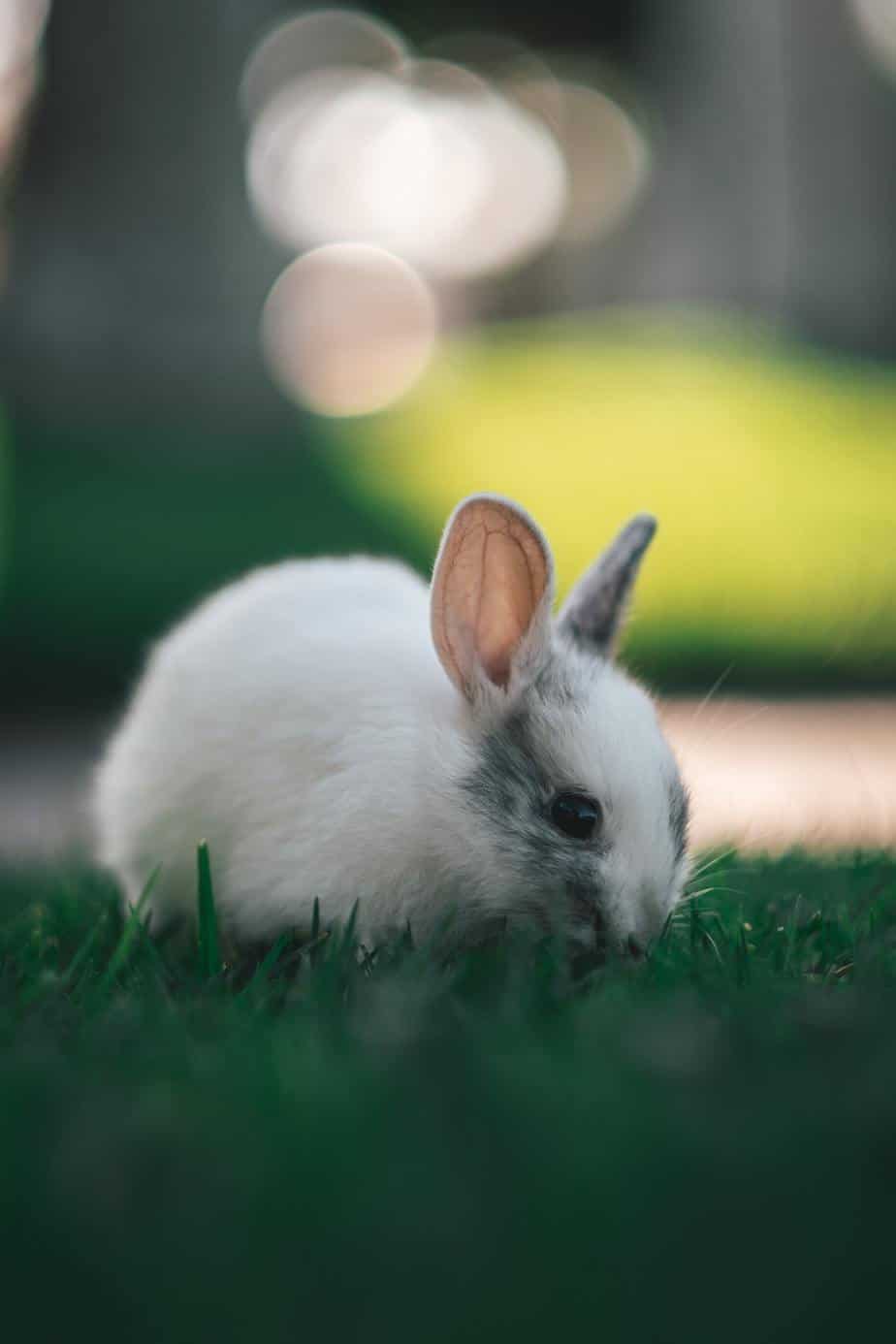
| Care | Size | Lifespan | Temperament | Health Issues | |
| Chinchilla Rabbits | Low Grooming | 9-12 Pounds | 5-8 Years | Docile, Gentle, Playful, Calm, Intelligent | Malocclusion, Mites, Flystrike, and Cancer |
The chinchilla rabbit is a mix of wild rabbits with Beveren and Himalayan rabbits that weighs up to 12 pounds. They are known for their coloring and include several different breeds, such as the American Chinchilla. They can live up to 8 years and require very little grooming. The only recognized coat color of this breed is the color of a chinchilla. (a dark slate blue-gray)
Chinchilla rabbits are known to be very calm and love to be held. While these rabbits need a lot of space to exercise daily, they are also intelligent playful rabbits that crave attention.
Chinchilla Rabbits are most commonly susceptible to Overgrown Teeth, Mites, Flystrike, and Cancer.
12. English Lop Rabbits
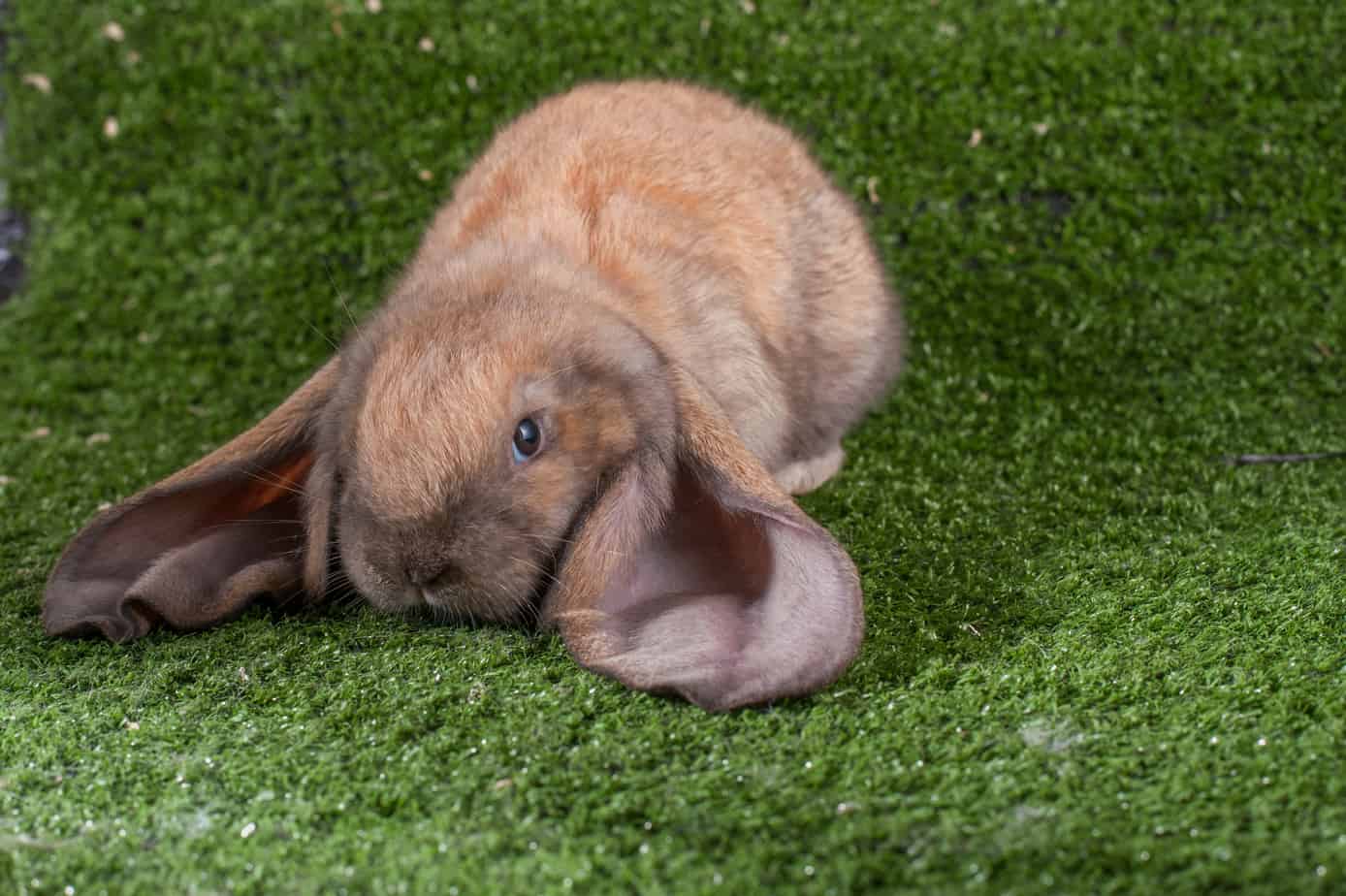
| Care | Size | Lifespan | Temperament | Health Issues | |
| English Lop Rabbits | Low Grooming | 9-12 Pounds | 5-8 Years | Laid Back, Gentle, Calm, Inquisitive | Ear Problems, Mites, and Cancer |
The English Lop is known for its ears, in fact, the longest rabbit ears in the world! They are also known as “the dog of the rabbit world” as the result of their laid-back nature and calm demeanor. English Lop Rabbits don’t have a maximum weight, according to ARBA, but on average top out at about twelve pounds. Because their ears are so long, you should make sure your rabbit’s nails are regularly trimmed.
English lops coat colors often include:
- Black
- Broken (solid color broken by white)
- Blue
- Red
- Opal
English Lops are known to be laid back and love to play. They are an excellent pet to have with children but should never be taken outside of the home. This breed also tends to suffer from ear mites more than other breeds.
13. Netherland Dwarf Rabbits

| Care | Size | Lifespan | Temperament | Health Issues | |
| Netherland Dwarf Rabbit | Low Grooming | 1-3 Pounds | 10-12 Years | Skittish, Aloof, Lively, Spunky, Slightly Wild | Malocclusion, Colic, and Cancer |
The Netherland Dwarf is known for its short, upright ears. They are tiny and weigh only one to three pounds. Additionally, these rabbits can live up to 12 years. They are susceptible to developing malocclusion, so make sure to regularly visit the vet to make sure their teeth are healthy.
As for coat color, Netherland Dwarfs come in:
- Blue
- Black
- Cinnamon
- Opal
- Tan
- Sable
This breed is not recommended for children because they are skittish, but they do love being outside. After a bond is built, they tend to be less nervous. They like quiet environments and tend to be aloof, so if you take them outside, make sure it is in a rabbit-run and that they are supervised and away from predators.
14. Florida White Rabbits
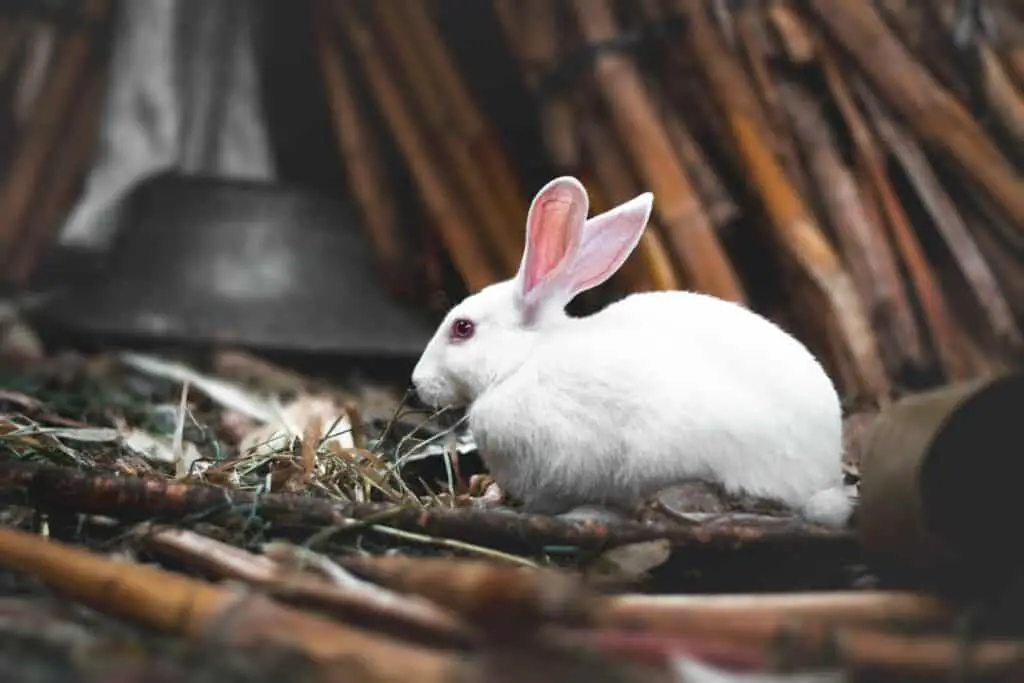
| Care | Size | Lifespan | Temperament | Health Issues | |
| Florida White Rabbit | Low Grooming | 4-6 Pounds | 5-8 Years | Calm, laid Back, Tender, Friendly, Fun Loving | Malocclusion, Mites, and Cancer |
Florida white rabbits are medium-sized and weigh four to six pounds. These rabbits can live up to eight years and originally were bred to be used in laboratories. They are also known to excel in rabbit shows. They have long, upright ears and soft, shiny fur and need very little grooming.
Florida White Rabbits, as the name implies, are white with red eyes.
The Florida white rabbit is friendly, Calm, and laid-back. They are great with children and love to play. Make sure to give them plenty of exercise and time outside of their cage. Florida white rabbits are a healthy breed and are not prone to any particular illness.
15. English Spot Rabbits
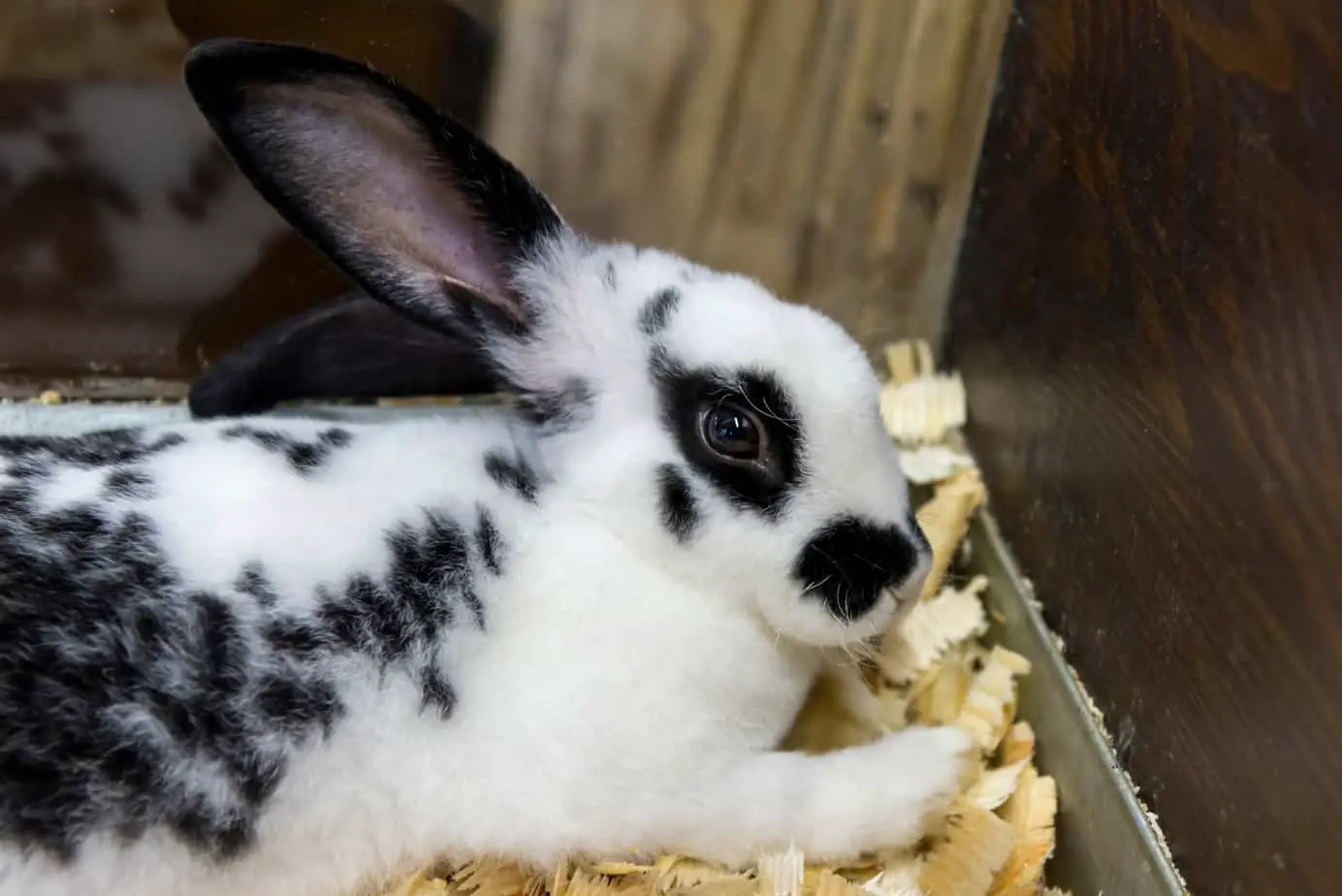
| Care | Size | Lifespan | Temperament | Health Issues | |
| English Spot Rabbit | Minimal Grooming | 5-8 Pounds | 5-9 Years | Energetic, Inquisitive, Playful, Friendly | Malocclusion, Mites, Flystrike, and Cancer |
The English Spot is a medium-sized rabbit that was bred for its distinct markings. They have white bodies and black ears, rings around the eyes, spots on their cheeks, and black or gray spots on their bodies. They can weigh up to eight pounds and usually live between five and nine years.
English Spots are great breeds for high-energy families because they are known for their speed and agility. Make sure to give them plenty of time outside of their cage to exercise and enough space for them to get their energy out. Since they have been bred to be used in shows for so long, they are accustomed to being pet.
Health issues for this breed include Malocclusion, Mites, Flystrike, and Cancer.
16. Polish Rabbits

| Care | Size | Lifespan | Temperament | Health Issues | |
| Polish Rabbit | Minimal Grooming | 2-4 Pounds | 5-9 Years | Energetic, Inquisitive, Playful, Friendly | Malocclusion, Mites, Flystrike, and Cancer |
The Polish rabbit is small, weighing about two to four pounds. They are not from Poland, as their name suggests, but they are from England. These rabbits are not miniature or dwarf breed; they are naturally small. They should not be allowed outdoors.
They are also known for their distinct colors, such as white with red eyes or blue eyes, and other colors and patterns.
Polish rabbits are known for how affectionate they are. They love children and to be held and pet. This breed doesn’t mind staying in small spaces, but they should be allowed to explore and become familiar with their surroundings daily Common health concerns include Malocclusion, Mites, Flystrike, and Cancer.
17. Flemish Giant Rabbits
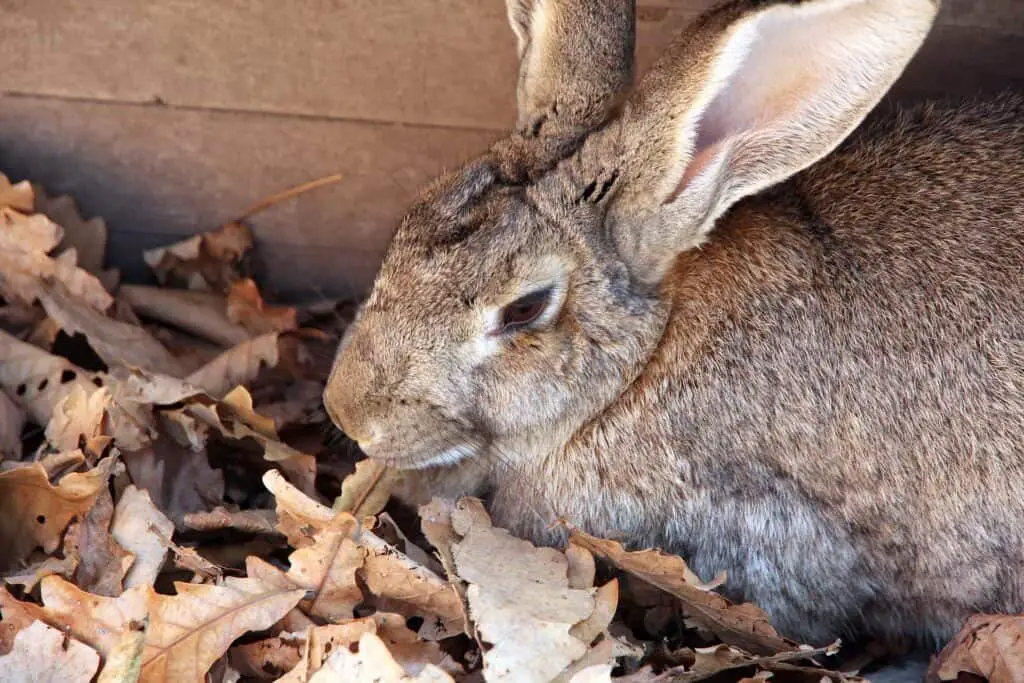
| Care | Size | Lifespan | Temperament | Health Issues | |
| Flemish Giant Rabbit | Minimal Grooming | 12-20 Pounds | 8-10 Years | Docile, Patient Tolerant, Friendly | Malocclusion, Mites, GI Stasis, and Cancer |
The Flemish Giant Rabbit is known for how gentle they, as well as their large size. They are known as the “Gentle Giants” of rabbits and can weigh over 20 pounds due to their breeding for meat and fur. They are excellent companions due to their docile and good-natured temperament.
Flemmish Giant rabbits come in a handful of colors including:
- Black
- Blue
- Fawn
- Light gray
- Sandy
- Steel gray
- White.
Flemish Giant Rabbits need plenty of space to exercise and a big cage because of their size. They are incredibly playful and get along well with children and dogs. While this is a healthy breed, Malocclusion, Mites, GI Stasis, and Cancer are the most common problems they encounter.
18. Jersey Wooly Rabbits

| Care | Size | Lifespan | Temperament | Health Issues | |
| Jersey Wooly Rabbit | Moderate Grooming | 2-4 Pounds | 7-10 Years | Docile, Patient Gentle, Playful | Malocclusion, Mites, GI Stasis, and Cancer |
The Jersey Wooly is a small rabbit weighing in at two to four pounds. They have long, dense fur and need to be groomed frequently to prevent their fur from matting. They can live up to 10 years and have short, upright ears.
Jersey Woolies come in a variety of colors and patterns including:
- Black
- Blue
- Chocolate
- Chestnut
- Pointed white
- Smoke pearl
- Siamese sable
Jersey Woolies aren’t very active compared to other rabbits but should still get time out of their cages to exercise. They are docile rabbits and are great with children. They are also known to have an excellent temperament and rarely kick or bite when they are upset. The Jersey Wooly is a healthy breed but can be susceptible to Malocclusion, Ear Mites, GI Stasis, and Cancer
19. French Angora Rabbits
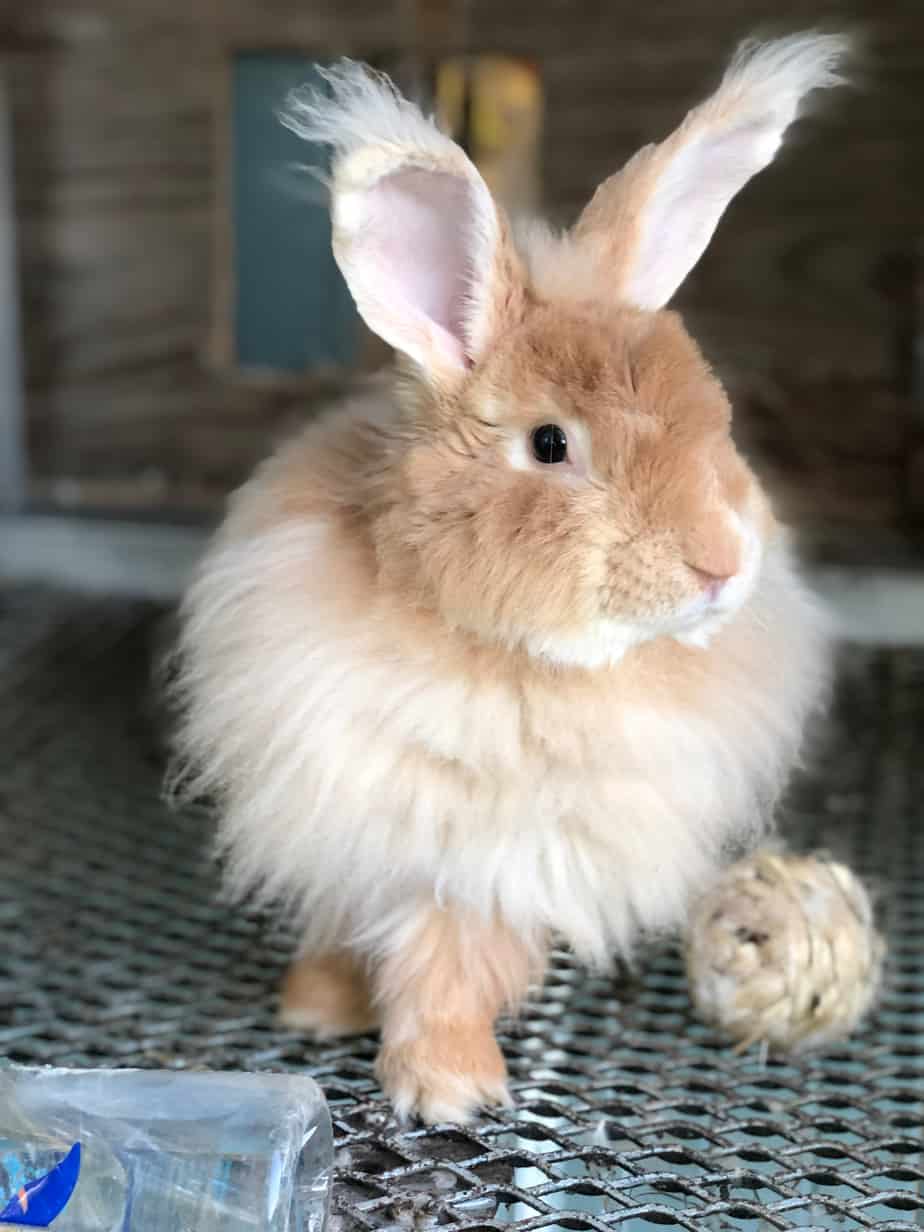
| Care | Size | Lifespan | Temperament | Health Issues | |
| French Angora Rabbit | Moderate Grooming | 7-11 Pounds | 7-12 Years | Calm, Patient Gentle, Friendly | Malocclusion, Mites, GI Stasis, myxomatosis, and Cancer |
French Angora Rabbits are known for their fluffy, long wool (not fur!) They weigh about 10 pounds and can live up to 12 years. They do need to be socialized, but once they have formed a bond with their owners, they are extremely friendly. Make sure to regularly groom your French Angora because their wool can get matted.
French Angora rabbits come in a variety of colors including:
- Black
- Blue
- Chocolate
- Lilac
- Fawn
- Orange
- Creme
- White
French angora rabbits make excellent companions and are calm, gentle, and patient when training. This breed can suffer from Malocclusion, Mites, GI Stasis, myxomatosis, and Cancer.
20. Harlequin Rabbits
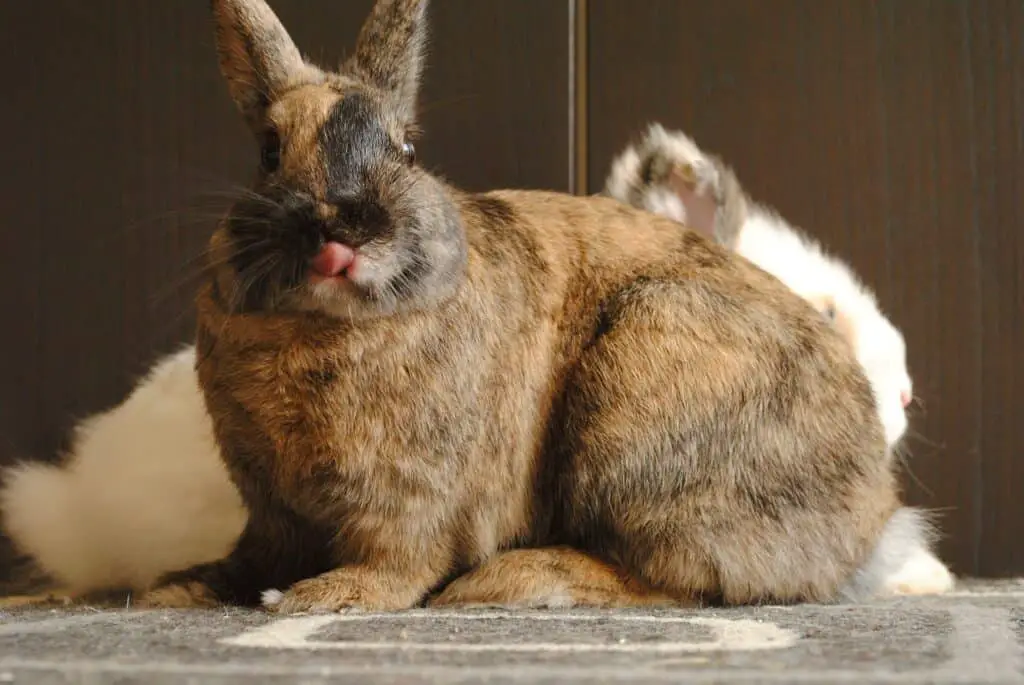
| Care | Size | Lifespan | Temperament | Health Issues | |
| Harlequin Rabbit | Minimal Grooming | 6-10 Pounds | 5-8 Years | Playful, Docile, Intelligent Gentle | Malocclusion, Mites, GI Stasis, and Cancer |
Harlequin rabbits come from France and have two breeds that show in their coloring, the Japanese and Magpie. Harlequin rabbits are known for the split of two colors on their faces. They are medium-sized, weighing up to ten pounds, and live five to eight years.
Japanese Harlequin rabbits have an orange colored base coat with a variety of solid colors mixed in including:
- Lilac
- Blue
- Chocolate
- Black
Magpie Harlequin rabbits have an White colored base coat with a variety of solid colors including:
- Black
- Chocolate
- Blue
- Lilac
Harlequin rabbits love to exercise, play, and explore. Having an obstacle course or a spacious cage with multi-levels would be an excellent way to keep Harlequins stimulated and get exercise. They also have a great temperament and are ideal for teaching tricks to. These rabbits are generally healthy and are not prone to any particular condition.
21. Havana Rabbits

| Care | Size | Lifespan | Temperament | Health Issues | |
| Havana Rabbit | Minimal Grooming | 4-7 Pounds | 5-8 Years | Playful, Calm, Gentle, Affectionate | Malocclusion, Mites, GI Stasis, and Cancer |
Havana rabbits are known for their mink-like fur. They are a medium-sized rabbit that weighs four to seven pounds. Havanas live to about eight years old. They are very calm and friendly rabbits and aren’t very active, so you should monitor their diet.
Havana rabbits come in five colors, including:
- Black
- Lilac
- Blue
- Chocolate
- Broken (solid color broken by white)
Havana rabbits love to cuddle and play with humans. They also love children and quickly bond with their owners. While this is a healthy breed, they can develop Malocclusion, Mites, GI Stasis, or Cancer.
22. Himalayan Rabbits
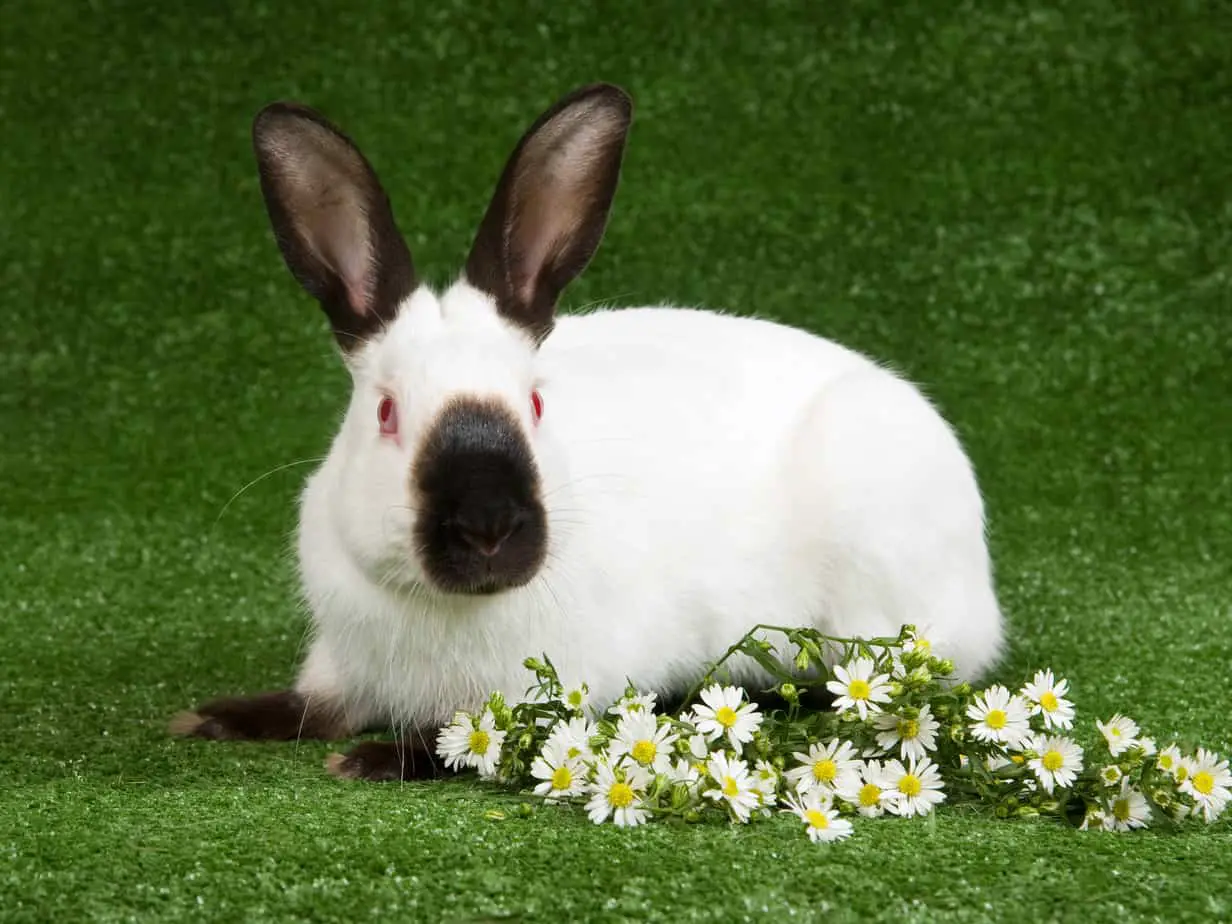
| Care | Size | Lifespan | Temperament | Health Issues | |
| Himalayan Rabbit | Minimal Grooming | 2-5 Pounds | 7-10 Years | Easy-Going, Gentle, Affectionate, Patient, Playful | Malocclusion, Mites, GI Stasis, and Cancer |
Himalayan rabbits are also known as the “Russian Rabbit.” Their body shape is unique because they are the only breed recognized by the ARBA with a cylindrical-shaped body. They weigh up to 5 pounds and can live up to 10 years. They were also used to create other breeds, including the Californian and Chinchilla, and requires little grooming.
The Himalayan rabbit is white with a variety of colored points including:
- Lilac
- Black
- Chocolate
- Blue
Himalayans have an excellent temperament and are very relaxed. They love to play and are incredibly patient. As bunnies, make sure to keep them warm because they are susceptible to the cold. Common health problems include Malocclusion, Mites, GI Stasis, and Cancer.
Do Rabbits make good House Pets?
Rabbits make excellent house pets and are incredibly social. A pet rabbit is the best fit for people living in small apartments or who have families with gentle children. While rabbits are relatively easy to care for, they require amp[le attention, socialization, and a quiet, safe indoor environment to be happy.
Rabbits are also quiet pets, so if you aren’t a fan of loud noises or animals, a rabbit is an excellent choice.
Contrary to the myth, rabbits are clean animals. They regularly groom themselves and most can be trained to used litter boxes. Do not give a rabbit a bath unless the vet recommends it. Baths can be traumatizing and stressful for rabbits and can kill some. The only way that your rabbit can smell up your home is if you don’t clean their litter box daily.
Is There a Specific Age to Adopt a Rabbit as a House Pet?
With so many breeds to choose from, you also have to decide on the rabbit age you’d like to adopt as your house pet. Ultimately, it is up to personal choice.
Like dogs and cats, many people prefer to adopt rabbits when they are younger in order to build an attachment. If you adopt a bunny, make sure to have it spayed or neutered first, usually done before six months old, before you take your new pet home.
Also, similar to dogs and cats, many other people enjoy adopting adult and senior rabbits for many reasons, including giving a rabbit a second chance. Rabbits are one of the most surrendered animals due to an owner being unable to care for them.
Do Rabbits Get Along With Other Pets?
Choosing a rabbit as a house pet is a big commitment, not only to time and attention but to the other pets that you have living in your home. Rabbits tend to do well with other prey animals like them.
Other Rabbits
Since rabbits are incredibly social, they love living with other rabbits and love to play and cuddle with each other. It is recommended for a rabbit to have another rabbit partner to live, play, and socialize with.
If you are going to have more than one rabbit in your home, make sure they are spayed or neutered if you don’t plan on breeding your rabbits. Additionally, it’s important to provide ample space for multiple rabbits in your home. Veterinarians recommended spaying female rabbits because it will protect them from uterine cancer, which is common in female rabbits.
Make sure to monitor two male rabbits if they are living together because they are known to be more aggressive than a male/female or female/female combination.
Dogs
Dogs are natural predators to rabbits, so many rabbit breeds will be skittish towards dogs. The way dogs and rabbits get along is more dependent on the dog’s demeanor, and dogs should always be supervised during play if you have a rabbit and a dog cohabiting.
Some rabbit breeds that are known to get along well with dogs are:
- Flemish Giant Rabbit
- Rex
- California
Since the relationship between rabbits and dogs is highly dependent on the dog’s temperament, make sure your dog isn’t a prey-driven breed. Some of the best dogs to have with rabbits are:
- Maltese
- Golden Retriever
- Pugs
Here is an excellent guide on how to train your dog to behave around rabbits and other small animals.
Cats
The relationship between cats and rabbits can be complicated at first and requires time to build up familiarity with space and scents. Cats are predators, so before they are socialized to be around your rabbit, you should always have them in a supervised room with places for the rabbit and cat to escape if they feel threatened.
Rodents, Birds, and Reptiles
While not as common as dogs and cats, rodents, birds, and reptiles may share a home with rabbits. Since they are often kept in their cages, you can have rabbits with these small pets, but with no interactions.
Rodents
The relationship between rabbits and rodents depends on the rodent. Rabbits tend to get along with guinea pigs but should be housed separately because each one carries a bacteria that can be lethal to the other. Rabbits are also known to be aggressive towards guinea pigs.
Do not keep a rabbit and a ferret together in the same house because rabbits are natural prey for ferrets.
Birds
Birds and rabbits can get along but should not be caged in the same room. Birds can be loud, and it can create a stressful environment for the rabbit. As with other animals, time out of the cage should be supervised, and you should monitor their behavior and interactions.
Reptiles
One reason reptiles should not be kept around rabbits is that they carry salmonella, which could kill a rabbit. Rabbits are also seen as prey for some reptiles, such as snakes.
Should I Allow my Rabbit to Roam the House or Yard?
Rabbits are active house pets. Many rabbit cages are too small for most rabbits. They should be at least five times the size of your rabbit. It’s also suggested rabbit cages are multi-level for them to be able to stretch and get exercise, even while cooped up.
You should let your rabbit roam outside of their cage for a few hours every day. Rabbits need plenty of exercise, and while they are small, they should at minimum have a rabbit-proofed room that they can play in.
Inside the Home
If you can’t rabbit-proof a room in your home, there are exercise pens that you can set up in an area in your home for your rabbit to spend time. Be sure to have different activities for your rabbits to do, such as toys to play with or an obstacle course. If you have toys and other animals, make sure your rabbit or other pet isn’t toy-aggressive and sharing the same space.
In the Yard
To know if you should let your rabbit out in the yard, make sure that your climate is habitable for your rabbit. Some breeds also thrive if they are outdoors such as:
- Belgian Hare
- Blanc de Hotot
- Californian Rabbits
- Netherland Dwarf
If you do allow your rabbit outside of your home, make sure to give them an enclosed space, such as a rabbit run, free of predators for them to roam, play, and exercise in.
How do you acclimate a rabbit to a new home?
Outside of researching the breed of rabbit you want as a house pet, there are several things you should do before adopting a rabbit. Most importantly, make sure your rabbit has plenty of space to stretch inside of its cage and gets exercise outside of the cage.
Rabbits like to chew on any and everything that is within range. Be prepared for the bottoms of your couches, electrical wires, and anything on the floor to be eaten. Ensure you hide all wires, place a gate around them, or keep them out of reach. As for furniture, you can use covers, barriers, and chewing deterrent sprays.
Rabbits also like to burrow, if you have a carpet, make sure there is some form of protection for it from your rabbit. Another way to prevent your furniture from being destroyed is to make sure your rabbit has plenty of activities to do. Outside of socializing with your rabbit, make sure that there is plenty of cardboard, such as a playhouse, for your rabbit to chew on.
Rabbit Veterinary Care
When adopting a rabbit, make sure that there is a veterinarian that is close by that is certified to treat rabbits. Not all veterinarians are, and this causes the price for a rabbit’s care to be higher. Some standard issues to watch for with every rabbit are:
- Ear mites
- Overgrown teeth
- Hairballs
- Uterine tumors (unspayed females only)
- Snuffles
Here is a more complete list of common problems with rabbits.
Learning Rabbit Body Language
While rabbits love to be pet, most do not like to be held. Rabbits will run away from you if you try to pick them up and hold them. If you want couch time with your rabbit, you can place a ramp for your rabbit to climb up the couch to lay next to you. Be mindful that rabbits love to burrow, so make sure you have a couch protector on.
Rabbits are one of the quietest house pets you can own, but occasionally make noises such as thumping or grunting. When a rabbit thumps, it usually means he is in some form of distress, whether angry or scared. This is an excellent way to understand how your rabbit feels, especially if you have small children or other animals in your home.
If your rabbit is not spayed or neutered, there are other behaviors that your rabbit can exhibit, such as:
- Boxing
- Mounting
- Spraying
- Lunging
Conclusion
Rabbits make excellent house pets for almost any home. Their different breeds leave them versatile in size, temperament, energy levels, and space required for a fruitful life. This makes it easier to find the perfect breed to have as your house pet because rabbits can fit almost any human home and personality.
